Surf Fishing Gear and Tackle: A Complete Guide
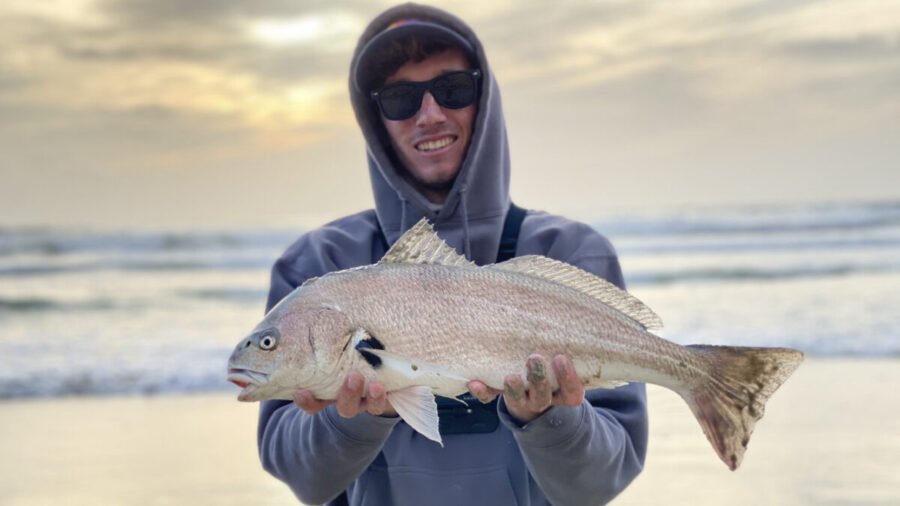
In this article, I’ll be showing you and explaining to you the gear and tackle that I use for surf fishing. This includes my rod and reel, as well as the rig I use with all of the terminal tackle. When it comes down to it, finding the right surf fishing tackle and gear depends on your preferences, but I’ll explain my preferences and why I use what I use.
Can you imagine how long it would take you to try and figure out what the best surf fishing rod is? Or the best surf fishing reel? Heck, it’d be nice if someone had already figured all this out and just showed you exactly what rig you need for surf fishing and all the surf fishing tackle that goes along with it. It would be nice… So I went ahead and did all of that for you.
There are 4 main styles of surf fishing that I regularly do. Each type of surf fishing requires it’s own set of gear and tackle, so I went ahead and broke this article into four very organized and detailed sections to leave little room for questions and uncertainties. Follow the links and you’ll have the best surf fishing gear and tackle in no time!
Table of Contents
- Light Tackle (Carolina Rig)
- Swimbait Set-Up
- Jerkbait Set-Up
- Shark Fishing
A Quick Summary Of My Gear and Tackle – Each Style
Light Tackle Gear
- Rod: Okuma Celilo (8’6″ MA) or the Okuma SST (8’6″ MA)
- Reel: Penn Battle II or III 4000 series
- Mainline: 15-pound monofilament
- For Bait: Carolina Rig:
- Leader Line: 15-pound fluorocarbon
- Swivels: 15-19mm barrel swivels
- Hooks: size #2 or #4 owner mosquito hooks
- Weights: 1-oz egg weight
- Beads: 8mm fishing beads
Swim Bait Gear
- Rod: Okuma SST-S-902HA – 1/2-2oz | 10-30lb | 9ft | H | MF
- Reel: Penn Spinfisher VI (3500 or 4500)
- Main Line: 30-pound braid
- Leader Line: 30-pound mono
- Lure Options:
Jerk Bait Gear
- Rod: Okuma SST (8’6″ MHA)
- Reel: Penn Battle II or III 4000 series
- Main Line:
- Leader Line: 15-pound fluorocarbon
- Lures: Lucky Craft FM 110 and Shimano WM 115 SP
Shark Gear
- Rod: Fiblink Moonsniper (12 or 13 feet)
- Reel: Penn Battle 8000 (II or III)
- Main Line: 50-pound braid
- Topshot: 100-pound nylon coated mono
- Leaders: Shark Leaders
- Weights: 8-ounce pyramid or 6-ounce sputnik
Light Tackle Surf Fishing Gear and Tackle
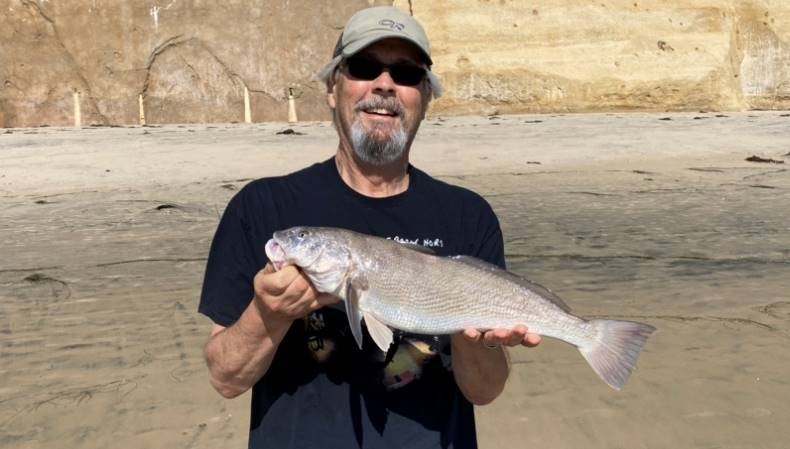
This set-up will be used to catch corbina, croaker, guitarfish, surfperch, and other light tackle species using a C-rig. While you can use the same set-up to throw lures for targeting halibut and other game fish, I recommend upping the action/rating for a lure throwing set-up. For example, I use a rod with a medium rating for light tackle surf fishing. For lures, I like a medium-heavy or heavy rating.
- Rod: Okuma Celilo (8’6″ MA) or the Okuma SST (8’6″ MA)
- Reel: Penn Battle II or III 4000 series
- Mainline: 15-pound monofilament
- For Bait: Carolina Rig:
- Leader Line: 15-pound fluorocarbon
- Swivels: 15-19mm barrel swivels
- Hooks: size #2 or #4 owner mosquito hooks
- Weights: 1-oz egg weight
- Beads: 8mm fishing beads
- For Lures: Lucky Craft FM 110 and Shimano WM 115 SP
- Other best surf fishing rods and best surf fishing reels
The Reel
So let’s start with the reel. The Penn Battle 4000 (II or III) is one of the best fishing reels out there and I simply love Penn as their saltwater products are super high quality. So whether for shark fishing or light tackle surf fishing, I like the Battle. If you want a higher quality and sealed spinning reel, go with the Spinfisher VI in the corresponding size/series.
The Rod
Let’s talk about this because the rod is something that I think becomes the most personalized aspect of your set-up. The Okuma Celilo 8’6″ MA is a fantastic rod with amazing sensitivity and a very responsive bend for mid-fight but it still offers great responsiveness for hook sets. The SST is a near identical rod but actually a step-up in Okuma’s line-up so it’s slightly higher quality. You can take your choice there. I absolutely love the feel of both of them for fighting fish and throwing the C-rig with a 1-ounce weight.
Main Line
You’ll start with your 15-pound mono for your main line. I use 15-pound mono and I’ll explain why. With a 4000 series reel, you can fit approximately 135-140-yards of 15-pound line on your spool. I always like to have at least 125-yards of line on my spool and I’ll never use anything less than 10-pound test.
Big spotfin, guitars, bat rays and leopard sharks can all easily snap 8-10-pound test either on that initial run, the set, or even the beaching process. I’ve hooked into 5-foot leopards on 10-pound test on sand crabs, so, in my mind, you want to be ready for those guys.
You want that balance between a heavier pound-test and a good amount of line on your reel. Usually, with spotfin, corbina, and all other light tackle species, you’re spool capacity won’t be tested, but it certainly might be if you get a big guitar, bat ray, or leopard shark. That 15-pound test mark is the perfect balance of enough line and a heavy enough pound-test. With a cast of about 20 to 30-yards, this should leave you with at least 80-yards to work with and that’s perfect.
Leader Line
So first off, here’s a video on how I tie my Carolina rig. It’s one thing to have the best surf fishing tackle and best surf fishing gear, but it’s another to know the proper rigs and techniques to use.
While we’re on the topic of lines, let’s talk about my 15-pound fluoro leader. Yes, For all the reasons listed above… that’s why I use 15-pound test. I’ve run into many anglers who insisted that 4 to 8-pound test was the way to go. It’s one thing to finesse a fish with proper techniques, but it’s another to actually experience and understand the hows and the whys.
Corbina are NOT line shy! I hear this one all the time. The simple truth is, they aren’t. They aren’t any more line shy than the next fish out there. Here’s my article on my explanation of why corbina are NOT line shy. However, I do use fluorocarbon for my leader line. Fluorocarbon is said to be virtually invisible in the water as its refraction is extremely similar to that of the water. Whether it matters or not, I see no reason not to use fluorocarbon as it’s cost effective when you’re only using 2-3 feet at a time.
Lighter Tackle With Sight Casting
What leads anglers to believe that corbina are so line shy is the actual method of fishing. Many anglers who target corbina partake in a method called “sight-casting”. This is where the angler spots the fish, times a cast in front of the fish and hopes for a bite. I have to admit, this is one of the most thrilling styles of surf fishing, but this method, if executed incorrectly, will result in a spooked fish. For a detailed overview on sight casting, read my Sight Casting How To article.
With sight-casting, the best tackle and gear for surf fishing may vary. Going lighter on the weight might help. Long story short (as this post was supposed to simply outline my gear and tackle), the reason the corbina will spook is not due to the line, but due to either the fish seeing/sensing the angler, or the fish sensing the angler’s weight striking the sand. In my experience, sight casting is most successful when you spot the fish from a distance and when you lead the fish by more than 10-15 feet with a timed cast that enters through the white water.
Terminal Tackle
Alright, so the rest of it is fairly simple. I’ll thread my 1-ounce weight onto my main line, then my protective bead, and then I’ll tie a barrel swivel on. Then, from the other end, I’ll tie my 15-pound fluorocarbon line (about 2 to 2.5-feet worth), followed by my mosquito hook. Depending on my target as well as what I think is biting, I’ll either do a #2 or #4 hook.
When all is said and done, your rig should look like the image below.
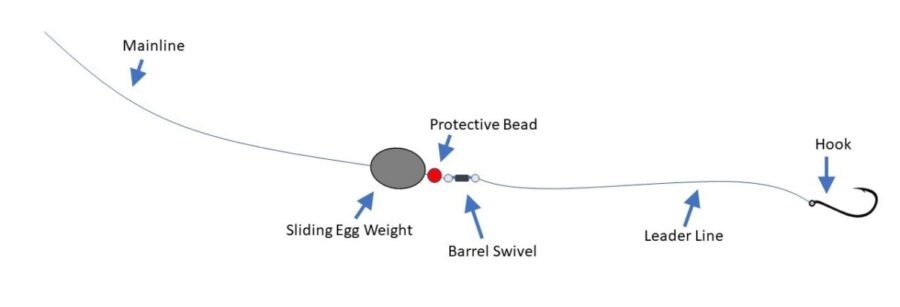
Best Set-up for Surf Fishing with Swimbaits
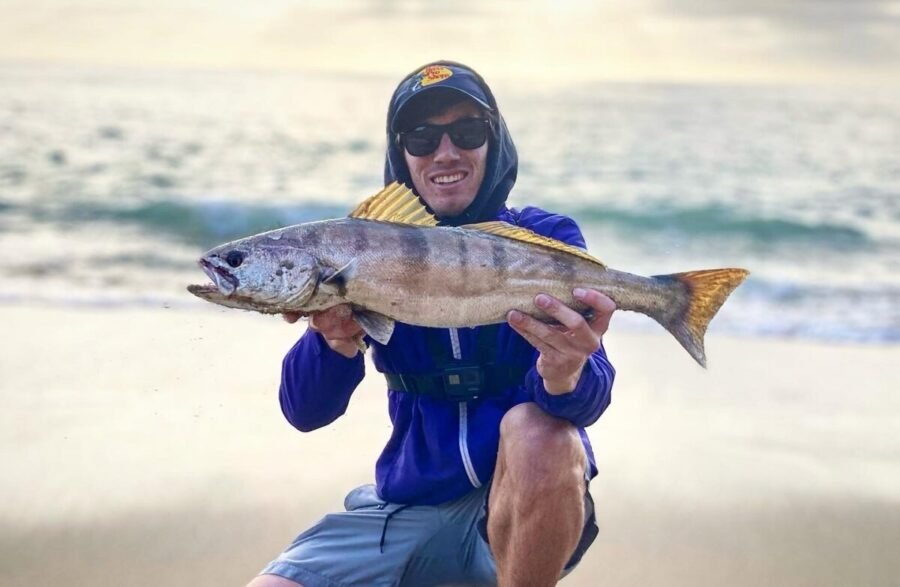
- Rod: Okuma SST-S-902HA – 1/2-2oz | 10-30lb | 9ft | H | MF
- Reel: Penn Spinfisher VI (3500 or 4500)
- Main Line: 30-pound braid
- Leader Line: 30-pound mono
- Lure Options:
- Lucky Craft FM 110 (jerkbait)
- Keitech Fat Swing Impact (4.8″) | Warbaits 0.5-ounce Weedless Jighead
- BioSpawn ExoSwim (4.75″) | Mustad KVD Grip Pin Swimbait Hook (5/0 | 1/8oz) (T Rigged)
This is the setup I use for halibut fishing, white seabass fishing, calico fishing and more. For more on this style of surf fishing check out my article on surf fishing with swimbaits.
How to Rig Up
Spool your 30-pound braided line onto your Spinfisher VI 3500 and then add your leader line (about 3-4 feet) by using an FG knot or a Double Uni knot. Attach your rod to your reel.
Rigging for the Texas Rig
(Biopsawn or Keitech swimbait with a Mustad KVD hook or Gamakatsu Superline hook… or something similar)
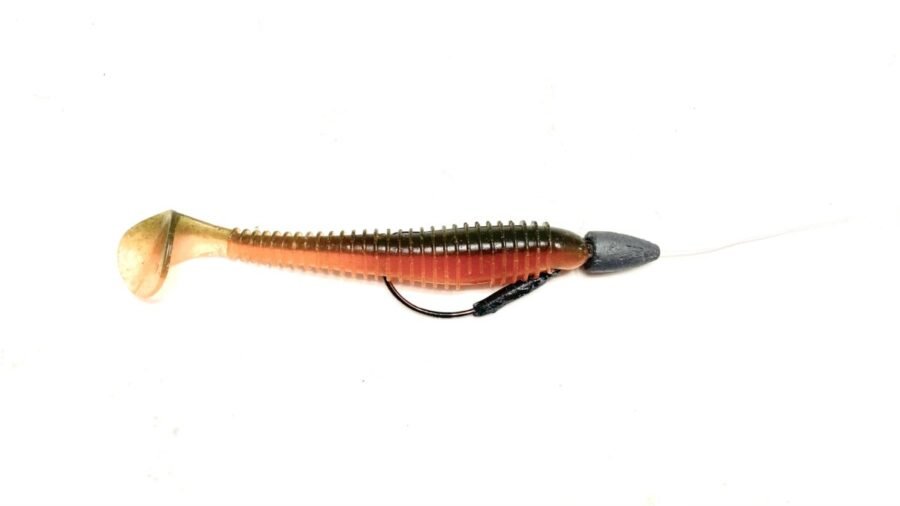
Sometimes pictures are easier to understand than words. So, take a look at the image above for what your finished Texas rig should look like and the image below for how to get there.
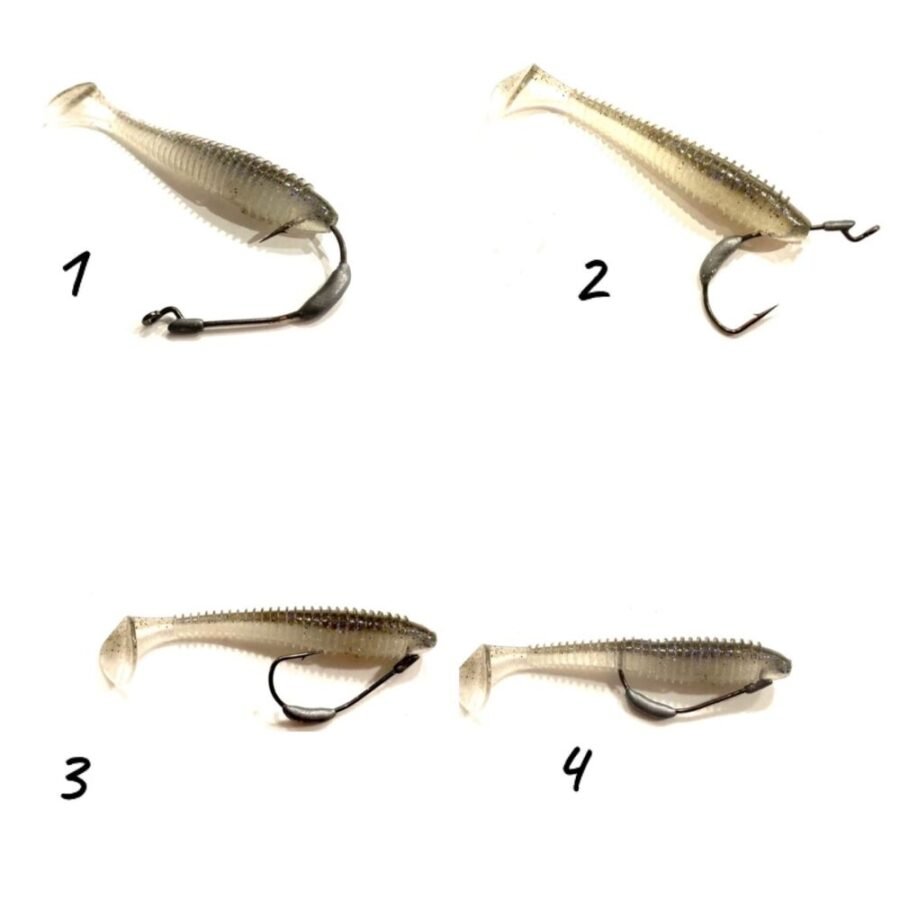
For more information on how to use a Texas rig for surf fishing, check out my article.
Rigging for Warbaits Weedless Jighead
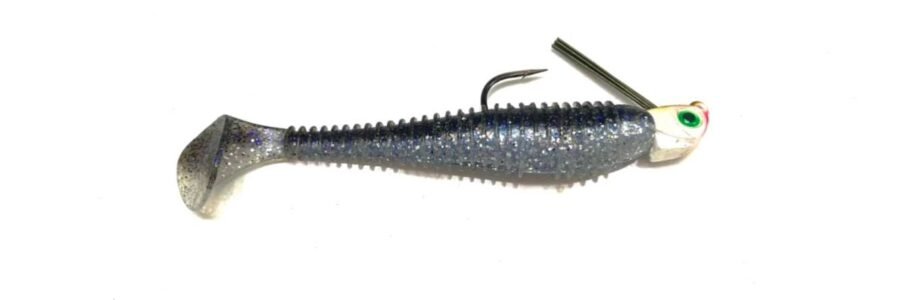
I’m not going to talk much more about surf fishing with swimbaits in this article. The image above shows you exactly how to rig the Warbaits weedless jighead with a swimbait.
Gear and Tackle for Surf Fishing with Jerkbaits
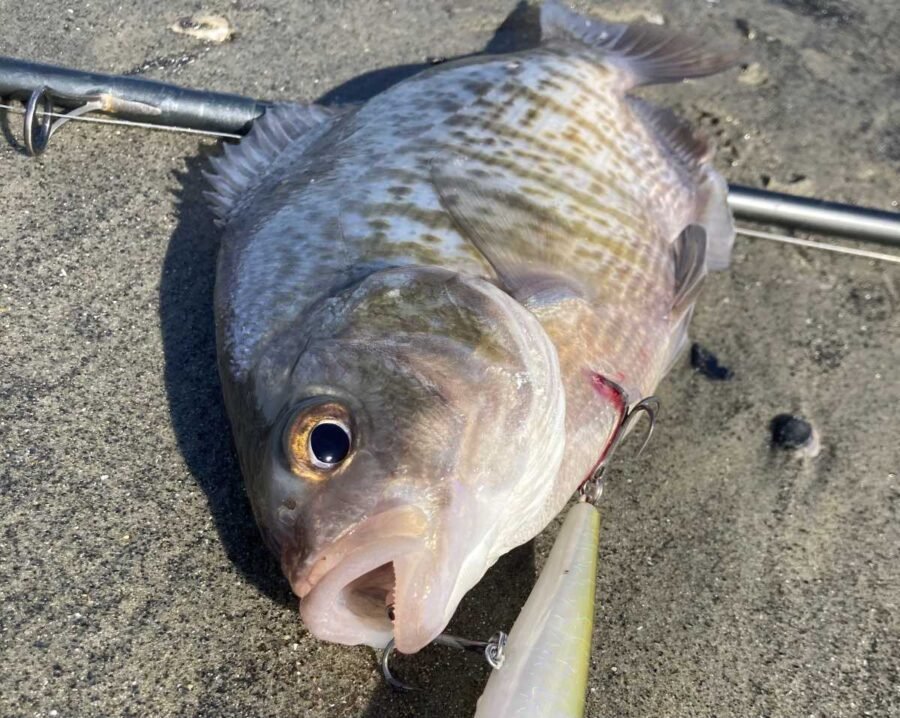
- Rod: Okuma SST (8’6″ MHA)
- Reel: Penn Battle II or III 4000 series
- Main Line:
- Leader Line: 15-pound fluorocarbon
- Lures: Lucky Craft FM 110 and Shimano WM 115 SP
You might be wondering why I use a different setup for surf fishing with jerkbaits vs surf fishing with swimbaits. The answer is because when I fish swimbaits, I’m fishing more rocky reef-like terrain where I need heavier line. I also need braid for swimbaits because swimbaits require a quick and firm hook set whereas jerkbaits do not.
Jerkbaits can be fished in more of a sandy structure with some nearby boulders, piers, or other structure that isn’t too crazy to the point of losing your lure every other cast. After years of trial and error, these are the two lure throwing setups I use and trust.
Rigging for Jerkbaits

If you’re using a jerkbait like the LC FM 110, you can get away with the rod mentioned in this section or the above section (SST 9HA or SST MHA). Bottom line though, you’ll simply tie the lure to your line and call it good. It’s that simple. Refer to the photo above.
As for using the braid vs the mono, that’s personal preference. To this day, I still use both for jerkbaits.
Shark Surf Fishing Gear and Tackle
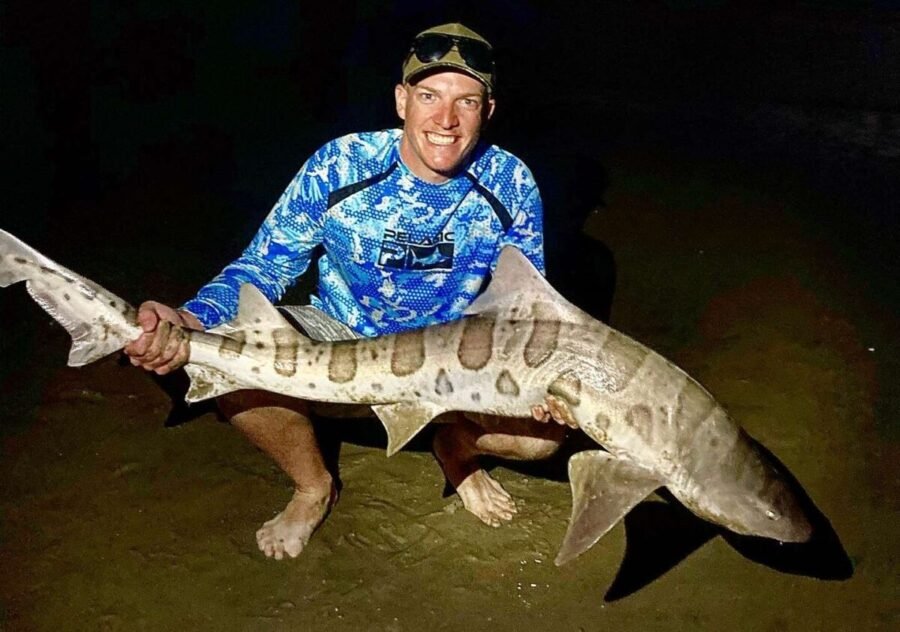
- Rod: Fiblink Moonsniper (12 or 13 feet)
- Reel: Penn Battle 8000 (II or III)
- Main Line: 50-pound braid
- Topshot: 100-pound nylon coated mono
- Leaders: Shark Leaders
- Weights: 8-ounce pyramid or 6-ounce sputnik
Specifications:
Rod and Reel for Shark Fishing
My go-to shark fishing rod for catching sharks from the surf in So Cal is the Fiblink Moonsniper (12 or 13 foot) spinning fishing rod. It’s sleek, strong, and provides great action for solid casts.
The Penn Battle II and III 6000 is an awesome reel! I’ve recently purchased a Penn Battle III 8000 series spinning reel and I think I’d lean toward that over the 6000s, but either one will do. I have zero complaints and highly recommend this reel to anyone looking to start surf fishing. The Daiwa BG is probably the most comparable reel to the Penn Battle and I’ve heard great things about both. You can always go with higher quality, more expensive set-ups, but this article is strictly about what I use as for now, this is the best surf fishing gear and tackle for me. I love the Battle and have no complaints.
Fishing Line for Shark Fishing
I use Power Pro (50-pound-test) braided fishing line for shark fishing in the surf. Spider Wire and a couple of other brands are solid too, and in all honestly, I’ve never had a bad experience with any braid, but Power Pro feels the best and seems to hold up the best for me.
After the braided line, you’ll want to put on a “top-shot” of 100-pound monofilament line. This just means that you’ll tie a line-to-line knot between your braid and mono. You should add about 20-30 yards of 100-pound mono (or fill until reel capacity is full). Don’t get intimidated by the line-to-line! It’s not difficult. If you’re too scared of tying a line-to-line knot, straight braid to your leader is okay (but not ideal) too, just make sure you tie your knot with a Palomar knot if you’re going from braid to leader. The line-to-line knot that I like to tie is called an FG knot (video) and it will provide a nice thin profile that can handle going through your rod guides with ease and no snags.
Top Shot
The reason we use mono for the “top-shot” is that mono can supposedly handle abrasion better than braid can. The closest line to the fish (other than the leader) will be mono and when the shark rolls or the skin rubs the line, your mono will be there to withstand it.
Braided line, while strong, is supposedly prone to snaps when confronted with abrasion. This is due to the nature of its engineering. Once a single strand is broken (in say, a 6-strand braid) it’s strength is lessened by 1/6. If two strands are broken, that 50-pound line will now be weakened by at least 33% bringing it down to say 33ish pound-test.
Once we’ve got the right rod and the right reel, and we’re all spooled up, we can get into the shark rig.
Shark Leader
For these, you’re more than welcome to make your own, but I do sell these and my shark rigs are available in double-hook and single-hook rigs.
If you’d rather make your own, here’s a list of materials in which you can make similar rigs.
- AFW 90 lb Nylon Coated Wire Leader Line
- 7/0 – 9/0 Circle Hook
- Three-way Barrel Swivel
- AFW .082-in Crimps
- 8-ounce Pyramid (or sputniks if conditions are bad)
Regardless, let’s go over the specifics on how to set yourself up with the best surf fishing tackle and gear to make a shark leader.
We’ve got a 3-way swivel which is attached to 90-pound AFW wire leader-line via (2) single-barrel crimps. From there, you have two options (which are displayed on the page where you can purchase my shark rigs: single-hooked rigs, or double-hooked rigs.
These hooks are hand-sharpened, 8/0 circle hooks. I typically use the single-hooked rigs, but some people like the doubles.
From the empty loop on the 3-way swivel, you’ll attach about 18 inches of monofilament line (25-50lb test) to your 6-ounce sputnik weight. I prefer my weight to be the same distance from the swivel as my bait – it makes for easier casting.
That’s your finished shark set-up and if you have any questions, leave them in the comments section at the bottom of this post.
Obviously, there really isn’t a correct way vs incorrect way to rig up your set-ups for surf fishing. This is simply what I’ve come to use and trust.
Any Questions? Let Me Know!
Please, if you have any questions or you’re unclear on something listed (or not listed), post it in the comments section at the bottom of the post. I’m always open to improving and modifying my set-up as well.
If you enjoyed the read and would like to be notified when similar articles or fishing reports are published, enter your email in the box below and hit subscribe.
And a huge thanks to all those who choose to shop through these links as you play a role in the funding of articles like this and all the other information provided within this website.
Subscribe below these article links!


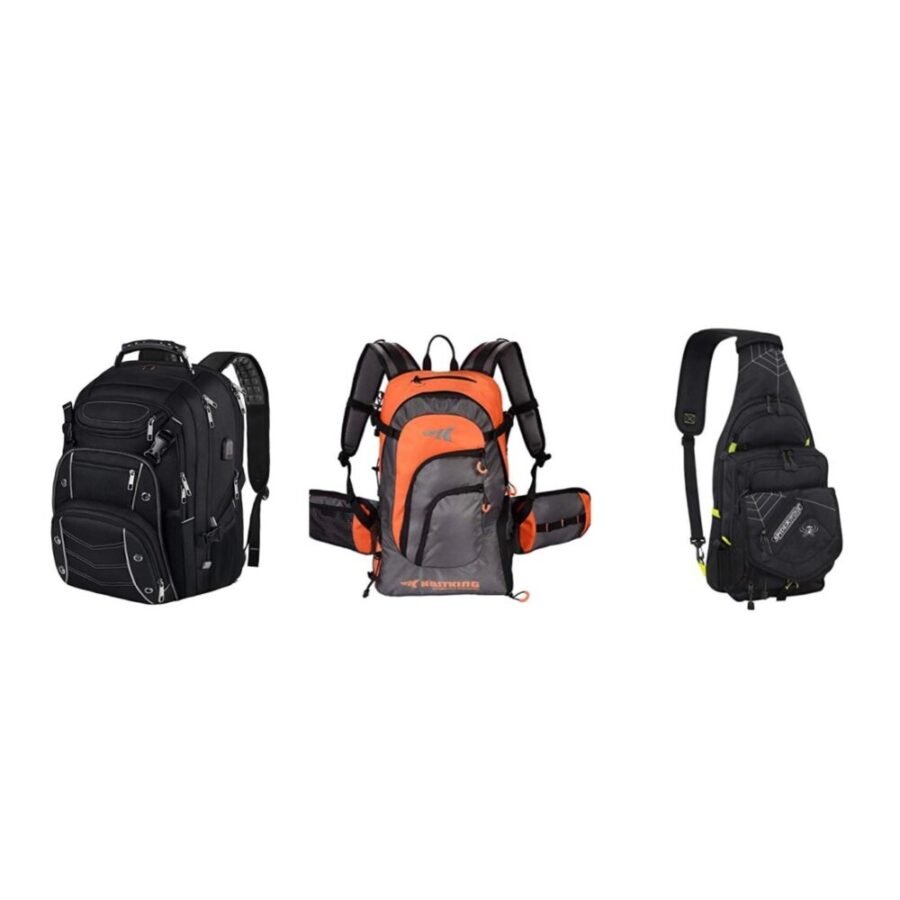
Great read! Thanks for the detail
No problem, thanks for reading!
Thanks for the info, I’m new in Oceanside and caught my first keeper corbina since I was eight, I’m 57 now and having a ball catching croaker and perch off the jetty. Can’t wait to get back out
Awesome! Lots of fun fishing the surf
New to surf fishing here. Got an ugly stik shakespeare combo and I’m fishing with lucky craft, and Cassina lures on 12lb mono. Sometimes I tie a carolina rig or a high low on 17lb Berkley Vanish fluoro… Well, fishing off manhattan beach – Playa del Rey and I’ve been striking out heavily this whole month. I’ll try a size 2 mosquito hook next time. Right now I’m using size 3/4 circle hooks. Sandworm lures, flukes, as plastics when not using the hard baits
Definitely give the Carolina rig a try with size 2 or size for mosquitos hooks and try either fishbites or mussel meat right now. That’s what’s working for me!
Thanks Nick!
Any time.
Do you have any pictures or video of your rig setups? It hard for me to tell how everything is setup from just descriptions.
Which rig/setup are you most curious about?
I can get on making a video, but I don’t have any at the moment.
Hey, Donald. Here’s a video for your reference I just made: https://m.youtube.com/watch?v=GwIarACtdS0
That’s the Carolina rig. My shark rigs are here for purchase: http://surffishingsocalsd.com/product/pre-made-shark-rigs/
Just add a weight with the same length of line as the wire leader to the hook.
I noticed that you put 15 lb test mono on the penn 4000 series reels. I’m new to surf and ocean fishing in general so forgive me if this is a dumb question. Is there any issue with putting 15 lb test mono on a reel that lists 8-12 lb test? Does it actually not really matter other than the amount of line you will have available on the spool? I looked into getting the 5000 because it looks like you could fit more 15 lb test but it is a considerably heavier reel than the 5000. By the way, thanks to your recs I have been having a blast bonding with my son at Torrey Pines surf fishing for perch and Corbina.
4000 is just a better balanced reel as you mentioned the weight of a 5000. The 4000 with 12-15lb should be enough to fight nearly anything on light tackle. 5000 would absolutely be fine too if you don’t mind a little clunkier set up. It really comes down to personal preference.
For example, I used a 5000 series reel for sharking for a while and never had any issues. Just moved to a 6000 series for a little more comfort.
Thanks so much for the information. It’s funny that I spend so much time fretting about what rod and reel to use. My 5 year old daughter wanted to get in on the action this past fall with her little 4 foot pole with a spin cast reel. Caught a surf perch on her very first cast and then caught another one on her second cast. She catches at least one with that little pole every time we go out!
Sounds about right, sometimes a 20 dollar Walmart setup will do just fine.
Awesome info Nick! Interesting to hear your experience with leader strength. I’ve personally found lighter leaders do make a difference and corbina are pretty line shy. I tried even an 8lb flouro leader for a while one summer only to switch back to my usual 4lb flouro leader. The number of bites I got with the 8lb was significantly less than the 4lb and it wasn’t just corbina…I caught less perch and croaker too (not sight fishing). I still hooked up with plenty of rays and guitarfish with the 8lb but those aren’t my target species…I want to maximize my opportunity for catching corbina, halibut, perch, and croaker. Landing big corbina on light line isn’t a problem at all if they are played correctly. I’m willing to risk snapping off a giant bat ray once in a while if it means I will catch more target species in the long run. But like you said, fishing is all about confidence and what each angler is most comfortable using. A 20lb leader seems excessive to me but I understand wanting that extra strength for whatever you might hook up with in the surf.
Thanks for the input, John. You could very well be correct. All said is my personal experience and nothing more. I will say, since this article was published, I’ve been using 15lb test and I think I’ll be using it for the foreseeable future as it seems more logical to keep 15 on 15. Never have I noticed any decrease in hookups regardless of line thickness but then again, you can’t notice what you don’t catch in some ways. Fully support trial, error, and different perspectives and ideas.
Thanks again for the engagement!
Is there any risk of snapping the rod tip of the medium Okuma by casting the 1 oz egg sinker since its max lure weight rating is only 5/8?
Well I’d say there’s always a chance of any rod yup breaking at any time. But that max lure rating is something I take as a recommendation. Long story short, I don’t think you’re at any risk. I use exactly that and I’ve never had any issues.
For example when I cast my shark rods, it’s rated for 4-8oz and I throw an 8 oz pyramid with close to 3 or 4 oz of bait which is about 12 total oz and I have no problem ever. Don’t go torquing the heck out of it, and you’ll be fine. Most of the time with Carolina rig, it flies plenty far with just a simple flick. Hope this helps. Again these are just my opinions and preferences. Some people use 3/4 oz and some even use half oz but I have my ways and I like them.
Thanks for the reply. I was deciding between buying the medium and medium heavy. I know the medium heavy is rated for 1 oz but I know its also stiffer and you probably lose out on some of the fight/fun that the medium offers. Knowing that you use the 1 oz on the medium without issues definitely solidified my decision in going for the medium. Thanks!
Awesome! Yah I always think the rod is 100% personal preference. As long as it does the job, whatever you like the most in terms of feel will suit you best and be best for you. Medium definitely has awesome sensitivity and great feel and bend in the fight. I would be tempted to get medium heavy if I were planning to throw LC lures on it just because I think the added “whip” would be nice. But, then again, I don’t have the medium heavy so I can’t know exactly what it’ll feel like I’m comparison to my medium.
I was initially thinking of the medium heavy precisely for casting the LC’s a bit further but from what I’ve read most halis and perch are caught only 20-30 yards from shore. In your experience does this hold true? Have you had success throwing the LC’s on your medium rod?
I actually never gave it a shot on my medium okuma celilo because I like the way my shorter medium penn pursuit feels. It’s a bit stouter with extra fast action. But you are totally right about halis being caught very shallow. I personally like to be able to cast those out as far as possible because the idea is that when you get it out far, you’ll work the shallow section any way and as a bonus you cover the far ground too.
Again, many anglers use even lighter rods, some use heavier. I persobally would lean toward the medium heavy if you really wanna work the LC. It’ll be good for both styles, and I doubt sensitivity will suffer. Only thing is you might not have as satisfying a bend mid fight.
So you make a really good case for 15lb. leader, then at the end of the essay you mess with my head by switching the conversation to 20lb. Under the heading “Terminal Tackle”. Typo? Or did I miss something?
That would be a typo. Thanks for pointing that out, Max.
Should be fixed now. There was a time, however, when I used 20-pound test and I can’t say I noticed a difference. The main reason I use 15-pound test is because I think it’s perfectly balanced for a 4000 series reel. Good reliability with good line capacity fit.
Thanks for all the amazing info and responses. Been learning a lot reading your site and also from the comments. One quick Q I had was around whether to go for a “solar reflecting” line. There is a lot of info out there that seems to indicate that having one of these helps with seeing your line and I can believe that. However, I bet the fish can see our line better too ;-).. Anyways. I was thinking of trying out the exact same berkley trilene line you recommend above in the “solar reflector” color as well to see how it works. I have my new rod and reel setup coming from your recommendations on this site. Hopefully I clicked the links right and you get the right credit for the super useful recommendations. Thanks again!
Thanks so much for the support and using my links! That’s a super interesting topic about the solar reflecting line. I would imagine the fish might see it more clearly but at the same time, I don’t know if it’ll really matter.
Either way, if you notice a difference, I’d be happy to hear about it and thanks again for all the support!
Thanks!
Thanks for the tips and great read/I’ve only surf fished once and came utterly improperly prepared…now a have the basics!
No problem, Jason! Hope this helps you get on some fun fish.
Hey I got to say that your are one of the few persons that really gives people the best shot at catching some fish, you give them all your knowledge and with a smile and that is awesome. I been fishing the surf for 30 years and I ran across some good old timers gave me a lot of fishing knowledge and I do just like they did to me and I myself do to others like you do now , that’s what makes a man a fisherman . I applaud you and your sharing your skills and and knowledge keep up the good work and keep Your line wet .
Thanks, Juan!
Thanks for all this good information.